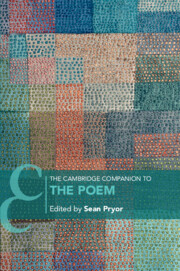Book contents
- The Cambridge Companion to the Poem
- The Cambridge Companion to the Poem
- Copyright page
- Contents
- Figures
- Contributors
- Acknowledgments
- Chronology
- Introduction
- Part I Ideas of the Poem
- Part II Forms of the Poem
- 7 Voice
- 8 Rhythm
- 9 Image
- 10 Sound
- 11 Diction
- 12 Style
- Part III The Poem in the World
- Further Reading
- Index
- Cambridge Companions To …
12 - Style
from Part II - Forms of the Poem
Published online by Cambridge University Press: 30 May 2024
- The Cambridge Companion to the Poem
- The Cambridge Companion to the Poem
- Copyright page
- Contents
- Figures
- Contributors
- Acknowledgments
- Chronology
- Introduction
- Part I Ideas of the Poem
- Part II Forms of the Poem
- 7 Voice
- 8 Rhythm
- 9 Image
- 10 Sound
- 11 Diction
- 12 Style
- Part III The Poem in the World
- Further Reading
- Index
- Cambridge Companions To …
Summary
This chapter examines the concept of style in terms of language and of representation. The style of a poem may first be understood as a problem of language at the level of the sentence. The analysis of style is then concerned with diction, syntax, meter, and other such linguistic features, and analysis can approach style as either a conscious choice or an unconscious reflex. But style is therefore also a problem of representation. For example, style may index the poet's character, gender, class, or any other aspect of their identity, and in this way, style is entangled in the specificities of social and historical life. Through detailed readings of poems by Margaret Cavendish and Harryette Mullen, the chapter then argues that the concept of style, both as language and representation, mediates between the one poem and the many. On the one hand, style customarily links one poem to other poems and indeed to other discourses and artforms. On the other, precisely because styles are shared and repeated a given poem may allude to or incorporate styles as part of its material and may, through this very process, affirm its own difference or even singularity.
- Type
- Chapter
- Information
- The Cambridge Companion to the Poem , pp. 196 - 210Publisher: Cambridge University PressPrint publication year: 2024



